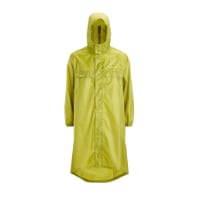Good point.
I would say to anyone planning walking a Camino, if you are overweight, lose the pounds/kilos before you start it. Don't depend on walking the Camino to do that for you.
@Mark Lee, this might not be the only sensible post here in this thread, but it does stand out from the pack of folk lore, urban myth and just plain nonsense (albeit, I detected just the faintest glimpse of humour in one or two posts). So let me add to the nonsense!!
First, there are no trusted authorities for any 10% rule, unless endless repetition to the point of folkloric status counts. Nor is there really any justification for a view that one should only need to carry x kg, or a pack of y li in volume. For a traceable view of this, I like the advice regarding weight given by Colin Fletcher and Chip Rawlins in
The Complete Walker IV. That is
The maximum for backpacking as an enjoyment is perhaps one-third of body weight. A well-conditioned body can handle more if necessary ... A reasonable load would be one-fourth or one-fifth of body weight. Unbearable Lightness would kick in down around one-eighth.
Noting that these authors use from the skin out (FSO) measures, and they also acknowledge that pack weights vary by season, I have estimated that the the lower limit of their guidance (one fifth of body weight) is roughly equivalent, in summer, in Spain, to a bare pack weight of around 10% of body weight.
Second, it is important to understand what body weight you are going to use. As your acute observation hints at, some of us are not the lithe and superbly fit specimens we might think we are. The ravages of time have not always dealt well with one or both of these! There is little science, but a lot of observation in my next remark. The weight you should use for any pack weight calculations should be your ideal walking weight, and unless there are significant extenuating factors, this should never be more than what your weight would be if you had a body mass index of 25 (I call this the BMI=25 point). Spending all day in a gym or being a muscle bound front row rugby forward or the American football equivalent might count as extenuating circumstances.
So, unless you are underweight already, it is probably best to ignore
@Tincatinker's earlier, mischievous, suggestion to bulk up. You would be better off taking
@Mark Lee's advice and losing weight.
Finally, what does that look like in numbers. If you are 1.75 m tall, your BMI=25 weight is around 76 kg. If, due to the ravages of time you are now obese (BMI>30) you would need to lose at least 15 kg to bring your actual weight down to your ideal walking weight. That might be difficult, and you might need a plan of several months duration to do that safely. I can probably find a source for this, but safe body weight reduction is about 2 kg a month. You are clearly unlikely to get that amount of weight reduction from adjusting the contents of your pack.
For the OP, my conclusions from this is both body and pack weight count: but
- if you are overweight or obese, reducing body weight is a better strategy to reducing your overall total walking weight;
- walking with less weight, whether it is body weight, pack weight or worn items is always better;
- noting that rules of thumb, weight limits etc are so much folk lore, and the captured wisdom might only apply to a very small range of circumstances, eg only be applicable for a summer camino, and no earthly use otherwise.





















